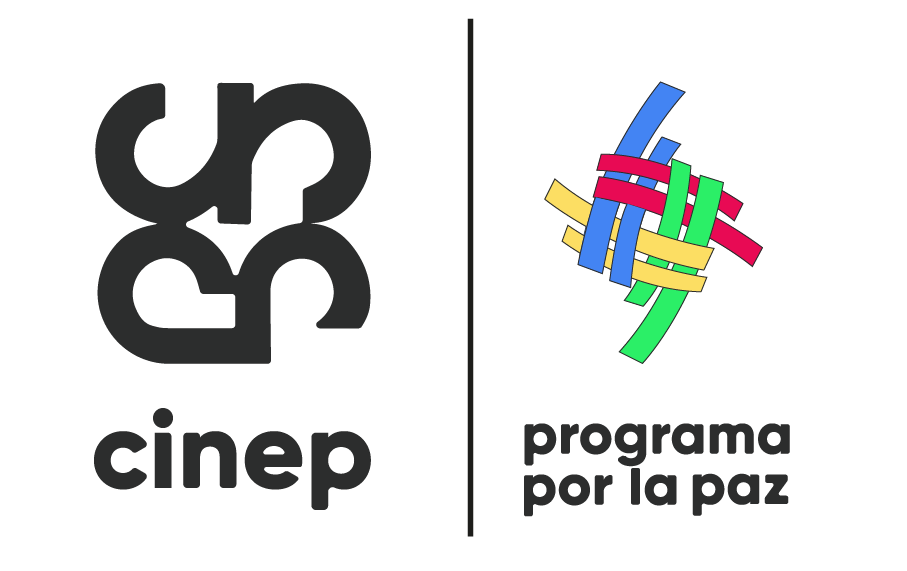In winter, communities in the rural area of María La Baja collect rainwater to meet their daily needs. When summer arrives, between December and March, the situation becomes more complicated, because water is scarce and the little that comes through the aqueduct, which comes from the reservoirs of the María La Baja Irrigation District and its tributaries, has a serious shortcoming: it is not drinkable.
In many cases, the water is not even suitable for bathing or other household activities, but out of necessity, many families end up drinking it. “I don’t drink it because every time I do, it gives me a stomachache,” says Nisley María Contreras, who represents dozens of women in the village of La Suprema who suffer from vaginal infections and whose only cure is to stop using the water piped into their homes from the region’s reservoirs and canals.
Leaders in Montes de María blame the poor water quality on the impact of extensive oil palm and pineapple plantations on aquifers. “The new development models that are coming to the area are blocking or contaminating water bodies. This has other consequences and affects health,” says Sofía Carrasquilla, leader of the Palo Altico community.
In María La Baja, women have played a leading role in the struggle for water and territory. They look after water, its access and quality, to make life in their communities possible and their territories habitable. “We are the ones who take the tank, we are the ones who take the water barrels and we are the ones who go out to fetch the water,” recalls Denilsa Julio, leader of San José de Playón.
VerdadAbierta.com spoke to women from San José de Playón, Palo Altico and La Suprema, rural communities in María La Baja, who are working to bring drinking water to their communities while public health continues to be affected by the lack of quality water.
Fight for the irrigation district
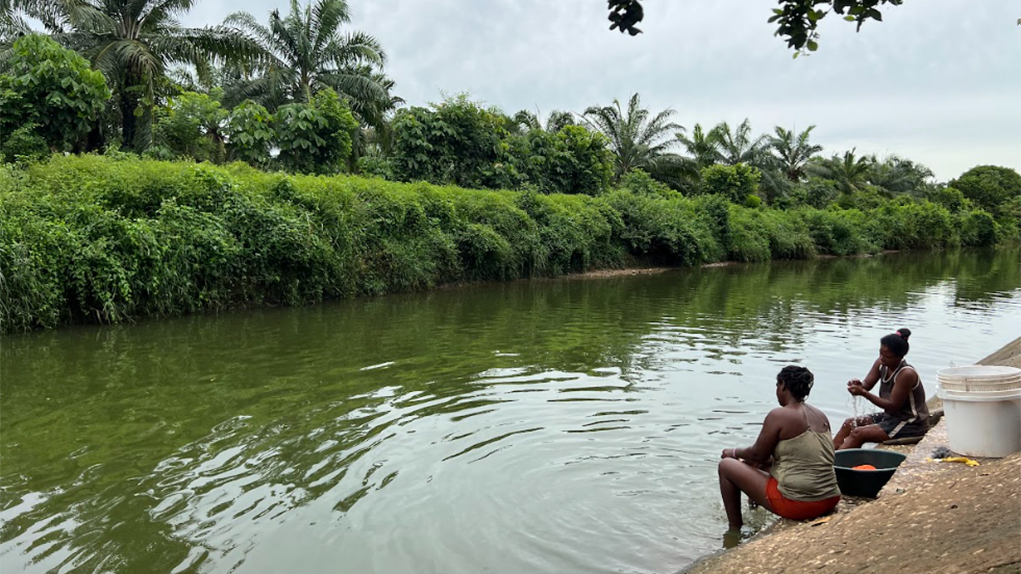
In villages and hamlets such as San José de Playón, Palo Altico and La Suprema, communities go about their daily lives between the canals and reservoirs, washing clothes and dishes, fishing and relaxing. In the background, the vast oil palm plantations remind them of their tensions with the industry over access to water.
These reservoirs and canals are part of the María La Baja Irrigation District, a huge civil engineering project built at the end of the 1960s, during the administration of the then president Carlos Lleras Restrepo (1966-1970), to bring water from the highlands and irrigate it through canal networks for the benefit of the population of María La Baja, Arjona and Mahates.
The project involved the damming of several streams and rivers in three reservoirs: Arroyo Grande or Playón, Matuya and Pondaje del Viento (better known in the region as La Piscina). In addition, more than 680 kilometres of canals were built to move water around the region.
“Today we can say that we don’t have water for consumption, and in some cases, we don’t even have water to do our housework, bathe or wash the dishes, nothing,” laments Sofía Carrasquilla, one of the leaders of Palo Altico, who blames the palm oil industry for drying out the land in María La Baja and receiving preferential treatment in the distribution of water from the Irrigation District. (Read more Where is the water in María la Baja? and Communities of the Montes de María fight for their right to water)
Although the irrigation district was designed to promote rice and livestock farming, rice imports increased in the early 1990s, affecting national producers and driving some out of business. This was followed by the emergence of oil palm plantations, which restricted access to water for farming communities.
According to the study Landscapes of everyday dispossession: land and water grabbing in Montes de María, Colombia, “the history of palm’s entry into the region is closely linked to the figure of the productive alliances led by Carlos Murgas Guerrero, known as ‘El Zar de la Palma’ for the 44,000 hectares he had planted by 2013 in Cesar, Bolívar and Norte de Santander.”
As well as the land, the water was also taken. “It is sad because it was not an irrigation district built for that purpose, but with a different political vision for the peasants,” laments Denilsa Julio.
Even though the Autodefensas Gaitanistas de Colombia (AGC), a group formed after the demobilisation of the paramilitary groups linked to the Autodefensas Unidas de Colombia (Auc), now control the Montes de María, the women of María La Baja and other communities have raised their voices to denounce the situation regarding water. (Read more in Social Leaders of María La Baja, in constant fear)
On the edge of Eden and without paradise

In the courtyard of her home in the village of San José de Playón, Denilsa Julio chops up pieces of cassava to feed to the pigs and sets aside a few more to supplement her family’s lunch. The palm roof is sooty from the smoke of the mud stove. For the soup that boils over the fire, she has taken the water from jerry cans covered with cloth that were filled with rain the day before.
Why doesn’t she drink the water from the aqueduct? “It’s water that smells very bad,” she replies sharply as she arranges the water barrels of rainwater on the earthen floor. “The little we do is to chlorinate it. We have to use it out of necessity,” Denilsa Julio admits with resignation, referring to the liquid they receive.
Born and raised in the neighbouring village of Cayeco, she arrived in San José de Playón in 2000, displaced by the violence unleashed by paramilitary groups in the 1990s. The Autodefensas Campesinas de Córdoba y Urabá (ACCU) were particularly active in the region, forcibly displacing thousands of families from Montes de María and dispossessing them of their land.
According to the Victims Unit (UARIV), on 31 October there were 36,300 victims of the armed conflict in María La Baja, of whom 35,302 were victims of the scourge of displacement. (Read more in The Terror that Displaced María La Baja and How the Tragedy of the Montes de María was forged). The document Characterisation of territorial conflicts in the Montes de María region, by the political scientist Tania Rodríguez Triana, states that between 1997 and 2007, 4,865 hectares were abandoned in María La Baja, mostly as a result of paramilitary violence. “The phenomenon of massive land purchases as a result of forced displacement and the systematic abandonment of peasant lands during years of armed harassment favoured the installation of the agro-industrial model of oil palm and timber production in the Montes de María,” explains the researcher.
“It was from there that the defence and protection of the land and our territory began because we know what we have lost since the expulsion,” says Denilsa Julio. In the mid-2000s she began to emerge as a leader, following in the footsteps of the Solidarity Development Corporation (CDS) and the Pastoral Social. Today she is a recognised spokesperson for the Displaced Population, Ethnic and Peasant Organisations (OPDs Montes de María).
Stomach pains and diarrhoea are common ailments among the inhabitants of this community, which they blame on the poor quality of the water. “When I arrived in Palo Altico, the water changed drastically. It affected me a lot, I had stomach pains, and it was very difficult for me to adapt to the water,” says Gabriela Castro, who has lived in the village for six years. Her mother’s family had settled on the land, but they were forced to flee to Venezuela in the 1990s because of the armed conflict but returned after a while.
Another common affliction suffered by these communities are the rashes and blotches that appear all over the body when they bathe in the water of the aqueduct. “There was a time when everyone here would say you’ve got the ‘jasa-jasa’. Everyone itched,” recalls Gabriela.
San José de Playón and Palo Altico are located next to Arroyo Grande, the main dam of the María La Baja irrigation district. As the leaders explain, and as confirmed to this portal by Aguas de Bolivar, the Bolivarian government agency responsible for managing aqueduct projects in the region, the liquid that is piped to the homes of the communities comes from this body of water, which is surrounded by innumerable oil palm and pineapple plantations.
“These large crops are sprayed with chemicals, and these chemicals end up in the dam. There are palm and pineapple plantations around the dam. There are palm trees planted on the water’s edge. When they pour chemicals directly into the water of the dam,” explains Sofía Carrasquilla, a leader of Palo Altico.
VerdadAbierta.com asked the Corporación Autónoma Regional del Canal del Dique (Regional Autonomous Corporation of the Dique Canal) (CARDIQUE), the environmental authority responsible for the María La Baja irrigation district, and the Ministry of the Environment if they were aware of the impact of palm and pineapple plantations on the banks of the dam on water quality, what studies they have carried out and how they control these crops, but at the time of going to press no response had been received.
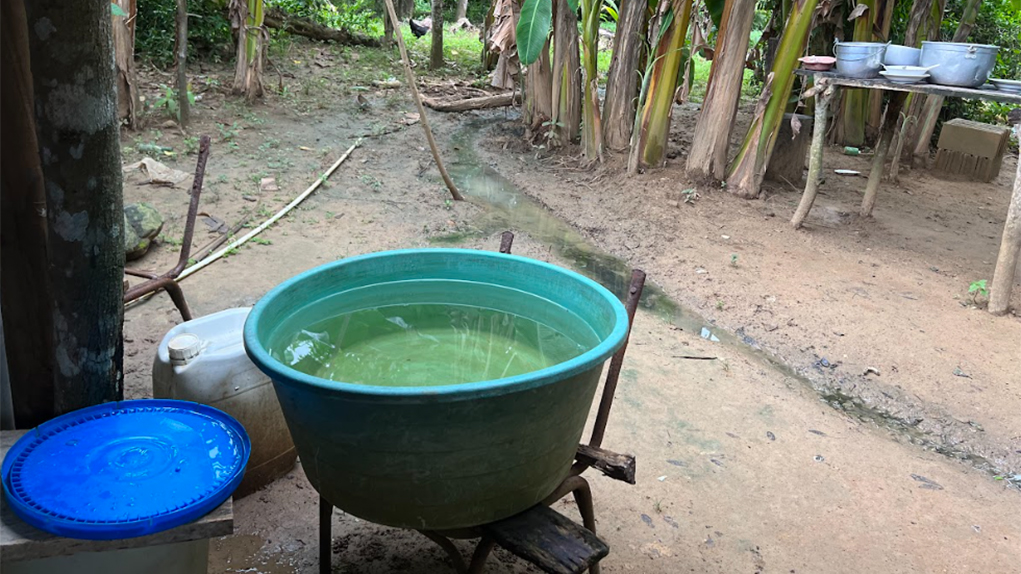
The struggle for water is not new. For years, communities have complained that the water supplied by the aqueduct is untreated and that agro-industry has an environmental impact on the dam. For this reason, instead of taking water from the municipal aqueduct, they have opted for other ways to get their hands on the vital liquid.
For decades, families in Palo Altico and San José de Playón have collected water from nearby wells. The two main sources are known as Leticia and La Neverita.
“The stories in the community were that everyone would go at night with a torch. It was like the party, the joy, ‘let’s fill the water’. Everyone would go to Leticia, they would get their supply from there. And there was La Neverita, a little further away from Palo Altico, which supplied the people of Playón,” recalls Gabriela.
Since the 1970s, the community remembers using the Leticia well for water, but at the end of the 2000s, businessmen planted oil palms around it, privatised it and it ended up drying. In the same way, La Neverita is surrounded by the same crops.
The leaders say that the owners of these plantations have fenced off the wells to prevent the community from getting water, and have cut off the roads that the villagers used in the past. They also claim that agrochemicals used on the oil palm have leaked into these water sources.
This situation has a particular impact on the lives of women, who, because of the sexual division of labour in these communities, have been given the responsibility of fetching and caring for water. This work, like many other caring tasks carried out by women, is not economically or socially recognised.
In María La Baja, in times of drought, when the wells go dry, they walk up to two kilometres, usually under the scorching sun, with 20-litre containers on their heads, to find a pump, or they dig artesian wells on the banks of the dam when the water level drops and there is water left over.
The remoteness of water sources in rural areas puts women at risk of sexual violence. The time spent fetching water also limits their opportunities for education, participation, rest and recreation.
Lucia Torres was born 54 years ago in Palo Altico. She is one of the women who, since childhood, have carried jerrycans of water from nearby wells or reservoirs for household consumption.
For some women in the community, this work has caused health problems. According to Gabriela Castro’s analysis of her work with the community, “almost 95% of the women here, especially the older women who have been doing this work since they were children, usually always have back or neck problems because each bucket is 20 litres of water on their heads. Lucía is one of the women in this community who complains of health problems caused by this work.
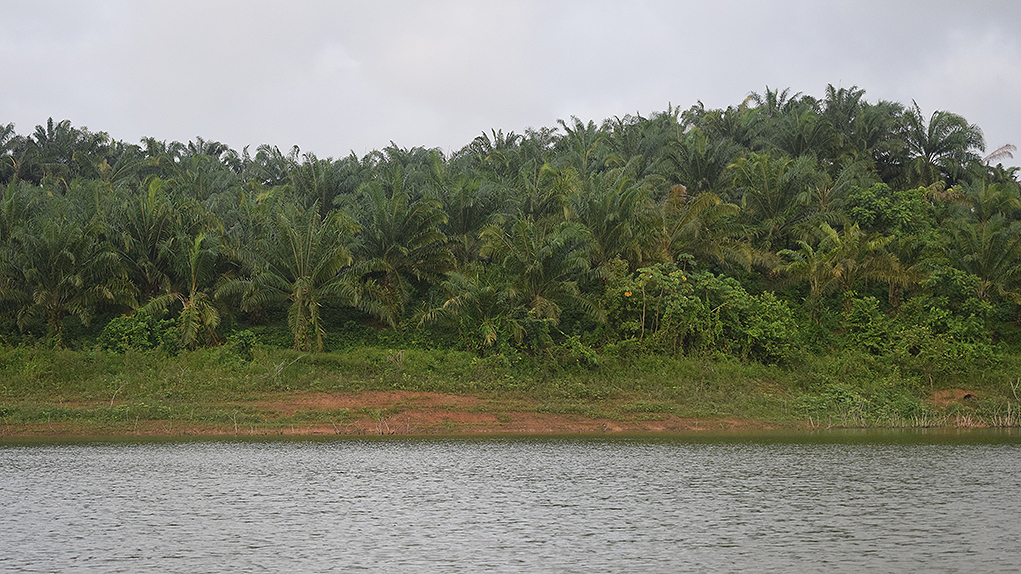
The leaders of María La Baja insist that the irrigation district was set up to support the peasants’ crops equitably, but with the arrival of monocultures in the region, the water from the dams and canals has been ‘privatised’. For this reason, the communities have clashed with the management of the system, which is the responsibility of the Association of Users of the Large-Scale Irrigation and Land Adaptation District of Maria La Baja (USOMARIALABAJA), which has been managing the irrigation district for more than 20 years.
“The owners of the water are not the small farmers, the small producers, but the large landowners, the owners of large palm plantations, of large pineapple plantations. That’s why they take care of the water, because sometimes in the summer when their jagüeyes (surface reservoirs) have water, we don’t even have enough to wash our clothes,’ Denilsa Julio complains.
According to USOMARIALABAJA, the irrigation district is supposed to provide water between January and June, the months of greatest drought. During the rest of the year, as winter sets in, the reservoirs will be replenished.
According to the company, there were 2,035 users as of July 2023. As for the sectors that use water from the irrigation district, Fredy Martínez Pereira, the company’s head of operations and conservation, says that palm oil uses 45 per cent of the water, rice 30 per cent and other crops – corn, cassava, plantain or grass – the rest of the percentage.
“Everyone has access to water, the difference is that water is a public service that has to be paid for to meet the needs of management, operation and conservation,” says the USOMARIALABAJA official. “We plan an irrigation campaign based on the amount of water we have available, and with this, we make a sowing forecast, and this sowing forecast is disseminated through a circular.”
In May 2019, the communities around the reservoirs reached an agreement with the rice sector after closing the sluice gates that distribute water to rice and palm crops, because, according to the communities, the businessmen were not using the water rationally after a strong summer. The agreement forced them to commit to using the irrigation district’s water sparingly.
The USOMARIALABAJA official stresses that when there are strong summers that threaten the amount of water in the reservoir, they carry out rotational irrigation in areas where users have paid for the service. “We try to use water efficiently and save it,” he concludes.
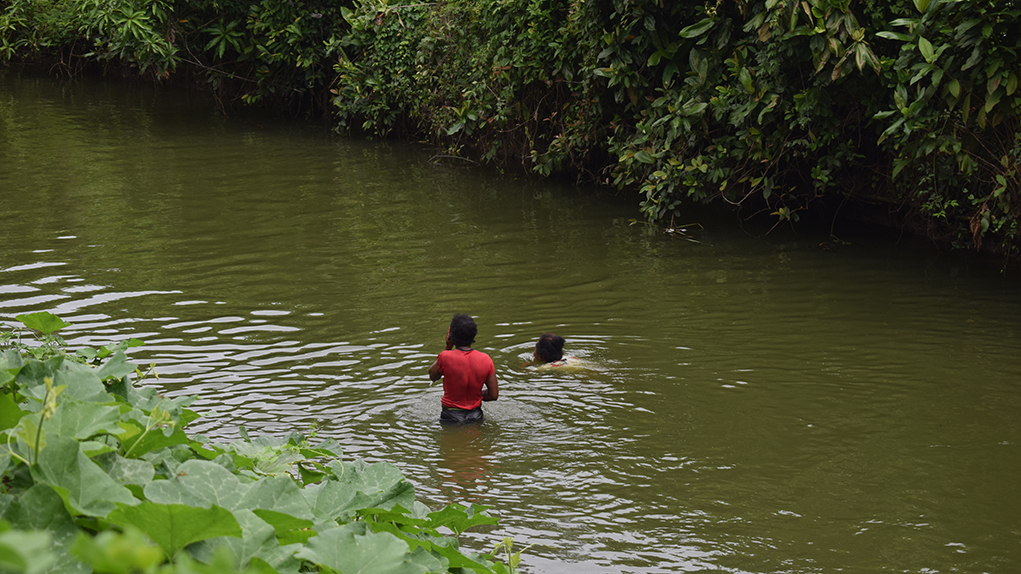
The leaders had several clashes with the palmeros over water. “One day we went to the highway – the road that connects Cartagena with María La Baja. We were demanding the right to water in a very peaceful way. With children and women and everything, the ESMAD (mobile anti-riot police) threw us out,” recalls Sofía, who says that several women were injured.
Faced with difficulties in accessing drinking water, in October 2018 the communities of Eladio Ariza (San Jacinto), the villages of Santo Domingo de Meza and Camarón (Carmen de Bolívar) and the village of San José del Playón (María La Baja) organised themselves to carry out the Ethnic Peasant Walk of the Montes de María.
The “marching process” reached the community of Turbaco and set up in front of the Bolívar governor’s office. During seven days of dialogue, the mobilisation managed to agree on technical tables for each municipality, highlighting the social problems of each community. The need for roads and drinking water was a common theme. Finally, it was agreed that aqueducts would be built in villages such as San José de Playón, Santo Domingo de Meza and Eladio Ariza to provide access to drinking water. But this has not happened.
“Because those in power are more interested in their interests than the interests of the community, today we have an infrastructure: we have a well, we have a tank, but the networks are useless,” laments Sofía Carrasquilla.
Following this mobilisation, 12 organisations came together in the Permanent Roundtable for the Right to Water, from which they have tried to dialogue with the institutions and monitor the water situation of the communities in the irrigation district and those living near the basins that feed the reservoirs. Denilsa and Sofía are two leaders who are part of this space.
As part of this effort, they have managed to consolidate reforestation projects with native trees from the tropical dry forest near the banks that feed the irrigation district, especially in communities like Carmen de Bolívar, and to review the legal situation of the lands on the banks of the irrigation district’s reservoirs, many of which are planted with palm and pineapple and are considered national wastelands.
The Mesa told the team that, to guarantee the right to water, they would continue to insist on the bathymetry – the measurement of the depth and level of the water – of the reservoirs and a study of the quality of the water found at depth (to detect components of agrochemicals), the review of the water concession in the hands of USOMARIALABAJA and the involvement of the communities in decisions on the use and management of the Irrigation District.
Ten years waiting for water and justice
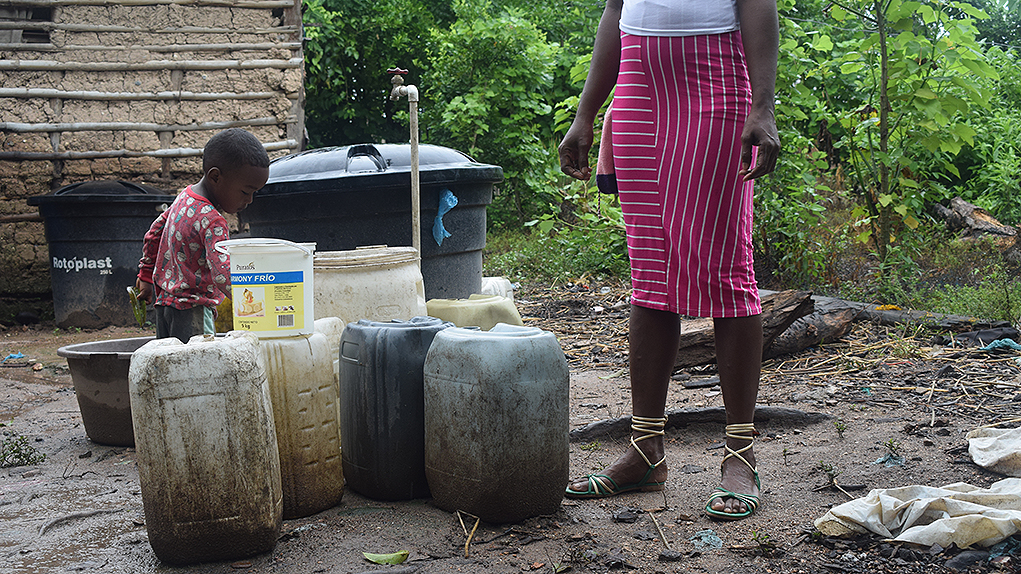
Between half a dozen water barrels and a 250-litre tank of water, the aqueduct pipe stands alone in the middle of the Carballo Monterroso family’s courtyard. It’s ten o’clock on a typical Thursday morning in La Suprema, in the village of Matuya, and Ana Milena Monterroso opens the tap in her courtyard, but nothing comes out. “Sometimes we go four or five days without water,” she complains. All the containers are supplies for an intermittent service.
Ana Milena takes one of the jerrycans full of water and pours it into another container, placing a sieve in the middle. More than a dozen tiny black-headed worms wallow in the mesh. They may be mosquito larvae that find their best habitat in the still water she and the other families in the village of María La Baja collect, but no one knows for sure, only that they appear in their water barrels.
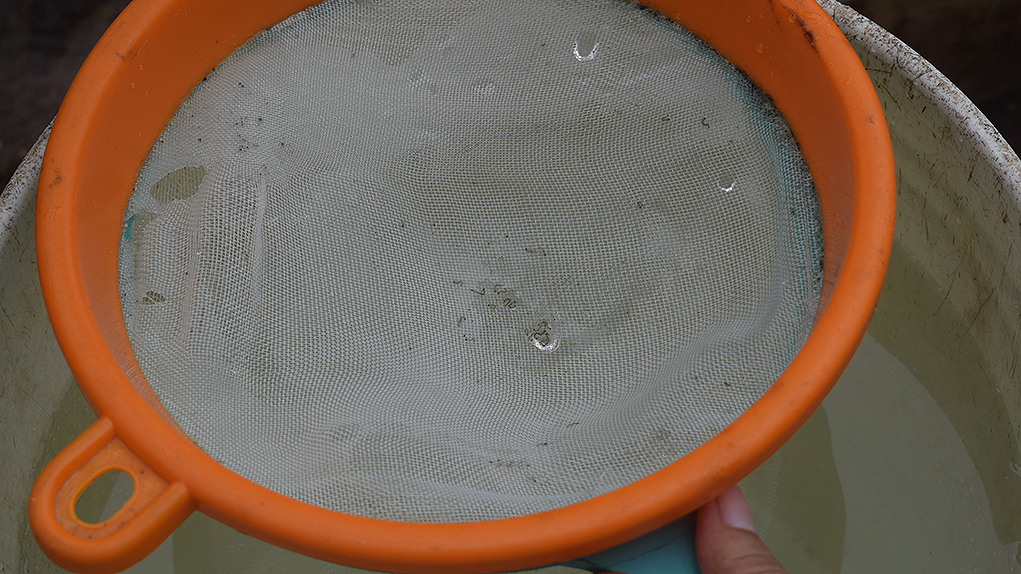
“When I came here, there was no water,” she recalls. She arrived in La Suprema in 2002, displaced by the armed conflict in Montes de María. At that time, the hamlet was made up of a few families who collected water, bathed and washed their clothes in the canal that runs in front of the village, fed by the Pondaje del Viento or La Piscina reservoir.
The women used to carry water in buckets on their heads, collecting it from natural ‘ditches’ that collected water from streams, but since the arrival of the oil palm plantations, the villagers began to fall ill. Their ailments were blamed on the agrochemicals from the plantations, which the communities believed were ending up in the water.
They often suffered from vaginal infections and skin rashes. “Most of us women here have suffered. There are girls here as young as two, three years old with outbreaks in the vaginal area. We have seen that it has decreased a bit, but it still goes on,” says Ana Milena.
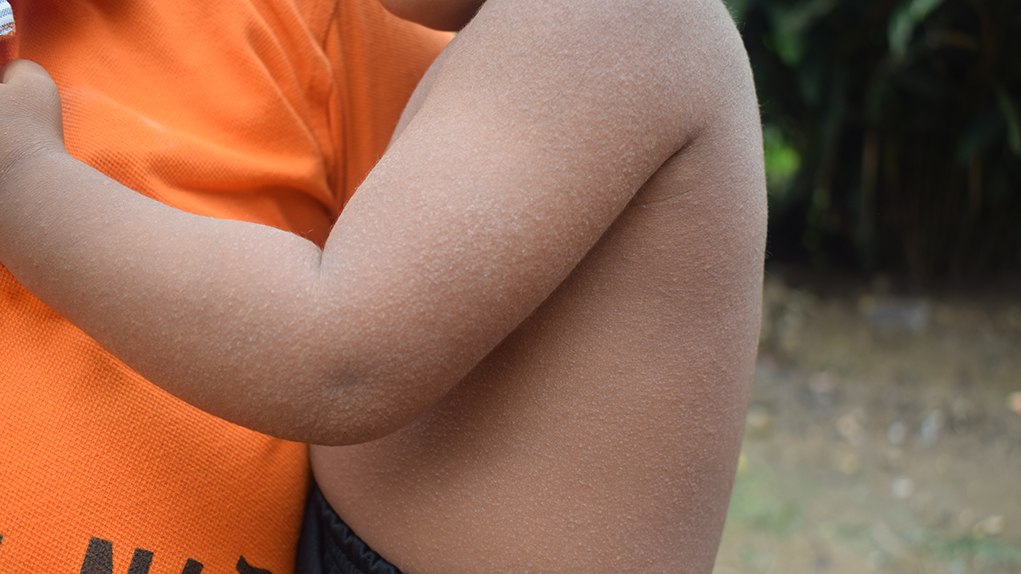
“The children have an allergy and you take them to the doctor, who prescribes medication, but the problem persists. The problem is the water. When the children bathe, I give them alcohol afterwards,” admits Emeris Estrada, one of the community’s elders, who has lived in La Suprema for 38 years. She admits, however, that out of necessity she has become a user of the water that comes out of the taps. “You take it to cook with,” she says, believing that boiling the water will make the illnesses disappear.
“The truth is that you don’t die of thirst. You have to drink whatever is available,” explains Danelis del Carmen Nisperuza, 28, who travelled from the neighbouring department of Sucre to La Suprema 40 days after being born. “During my second pregnancy, I had a serious vaginal infection and I also contracted toxoplasma (a parasite that causes infection) from the water. I almost lost the baby,” she painfully recalls, adding that there have been miscarriages in her community due to water consumption.
In other cases, the consequences have been fatal. The community recalls several cases of children who died after suffering stomach infections and skin problems due to the quality of the water. “About four children have died here because of the water. We say the water because the upset stomach, the diarrhoea, comes from the water,” says Emeris Estrada.
This was just one of the facts cited by the Latin American Institute for a Society and Alternative Law (ILSA) in a popular action filed in October 2011 before the Administrative Court of Bolivar, which sought to force the state to take the necessary measures to guarantee drinking water and an efficient basic sanitation system for this village and the rest of the rural communities of María La Baja.
“From the technical reports carried out on the water consumed by the population of the village of La Suprema, it can be concluded that the physical, chemical and microbiological characteristics of the water studied are alarming for the health of the community in question, generating a risk of morbidity and mortality among the inhabitants of María la Baja, especially among the child population, which has resulted in the death of 7 children in the community of La Suprema,” reads the popular action document.
Since August 2011, a report by researcher Rafael Fernando Oyaga Martinez has warned of the danger: “Consumption of water from this area should be avoided as much as possible if it has not been previously treated”. The researcher noted the high presence of E. coli (Escherichia coli), which “endangers the health of people who consume water from this area”.
At the time, ILSA drew attention to the state’s awareness of this serious situation. According to the document, at the beginning of the 2010s, the Territorial Health Plan of the municipality of María La Baja stated that the main causes of sickness in the municipality were diseases such as intestinal parasitosis, rhinopharyngitis and hyperthermia, among others.
This portal sent a questionnaire to the Mayor’s Office of María La Baja and the Ministry of Health and Social Protection to find out if the quality of the water has influenced the different diseases and deaths in the municipality and what measures both entities have taken to mitigate this scourge. Still, at the time of publication of this report, four months later, no response has been received.
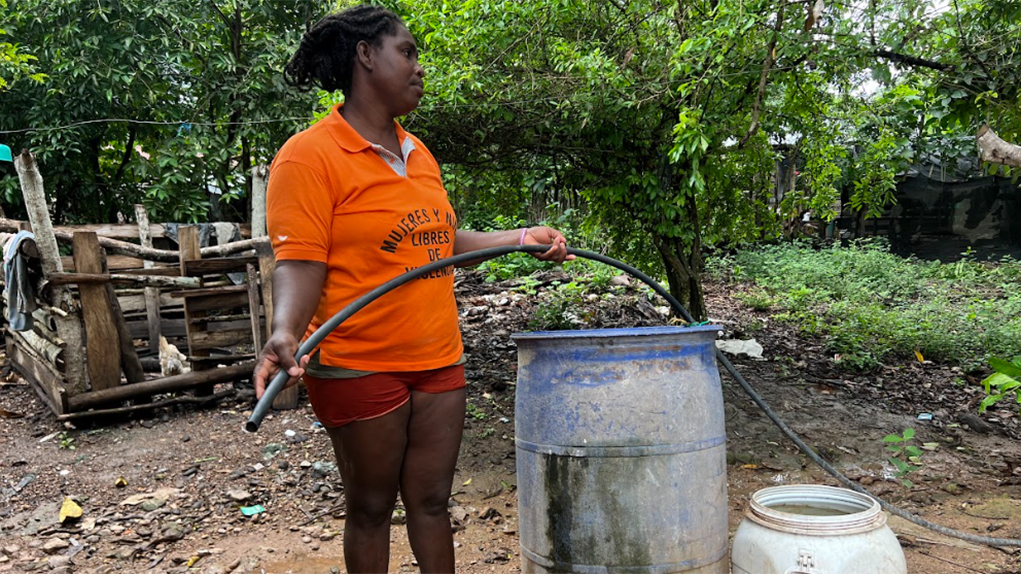
In 2013, the Bolivar Departmental Health Secretariat collected water samples for bacteriological and physico-chemical analysis. The Water Quality Risk Index for Human Consumption (IRCA) is the degree of risk of human illness due to water consumption. According to the Superintendencia de Servicios Públicos Domiciliarios, the study showed a high risk index: of 51.40 per cent, or unfit for human consumption.
With all the evidence presented by ILSA, the court ruled in favour of the municipalities. In its judgement of 29 January 2014, the Court concluded that the right to a healthy and wholesome environment was being violated “due to the lack of efficient and timely provision of public water, sewerage and basic sanitation services in the municipality of María La Baja, particularly in the town of La Suprema”.
As a result, it ordered the municipality, Aguas de Bolívar, the Ministry of Health and Social Protection, and other state agencies to take measures to ensure the provision of water and sanitation services in María La Baja, and gave them one and a half years to provide timely and efficient services.
One of the interim measures ordered was the delivery of drinking water by water trucks. “The truck came once or twice, and you only had the right to fill two or three water barrels, because the truck was not enough for the community. The garbage truck also came once or twice and never came again,” Danelis complains.
The Bolivarian government, through Aguas de Bolivar, carried out some work in La Suprema, including “the construction of an elevated tank and the replacement of the central pipe,” says Ana Milena, but the poor quality of the water persisted. Sofía Carrasquilla asks, “After the judge’s ruling, what more needs to be done to make it effective?”, but she gets no answer.
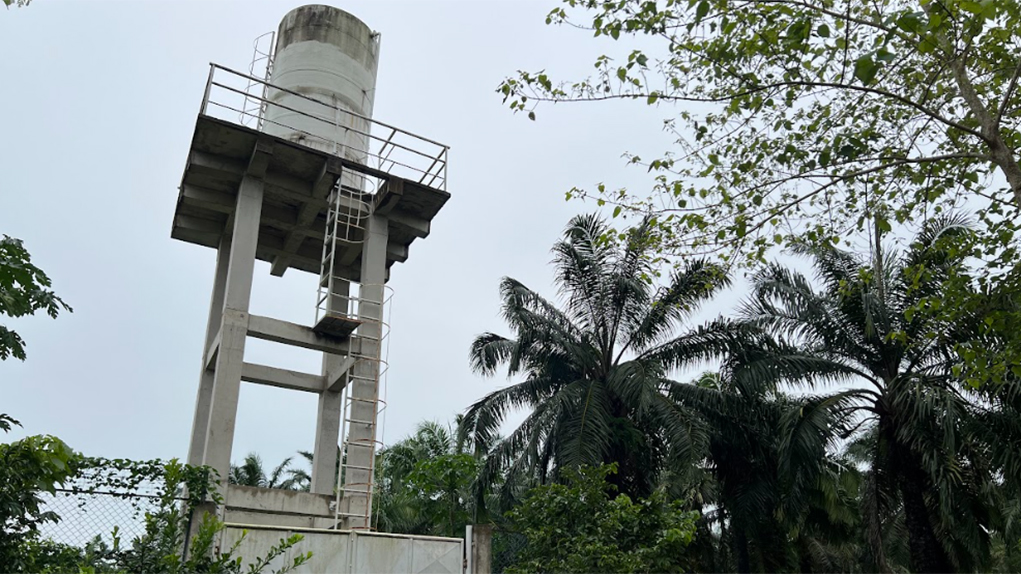
In April 2022, ILSA presented a report to the Truth Commission on the situation of rights in Montes de María, which included the inadequate public solutions in La Suprema: “The work is insufficient to consider that it provides an effective and timely service, as it lacks a constant chlorination system that makes it fit for consumption, it is water that does not reach the houses due to the incompleteness of the work, and that in its final reception presents turbidity and a high content of sediments”.
“The pipes have been replaced, but nothing else has been done in the streets, and what has been done is supposed to be for the streets only,” complains Ana Milena. Fearing that they would be left without water in their homes, all the families connected without replacing the old networks they had in their houses. “To get water into the house, you had to buy everything, and some people didn’t have the money to buy the pipes,” she complains.
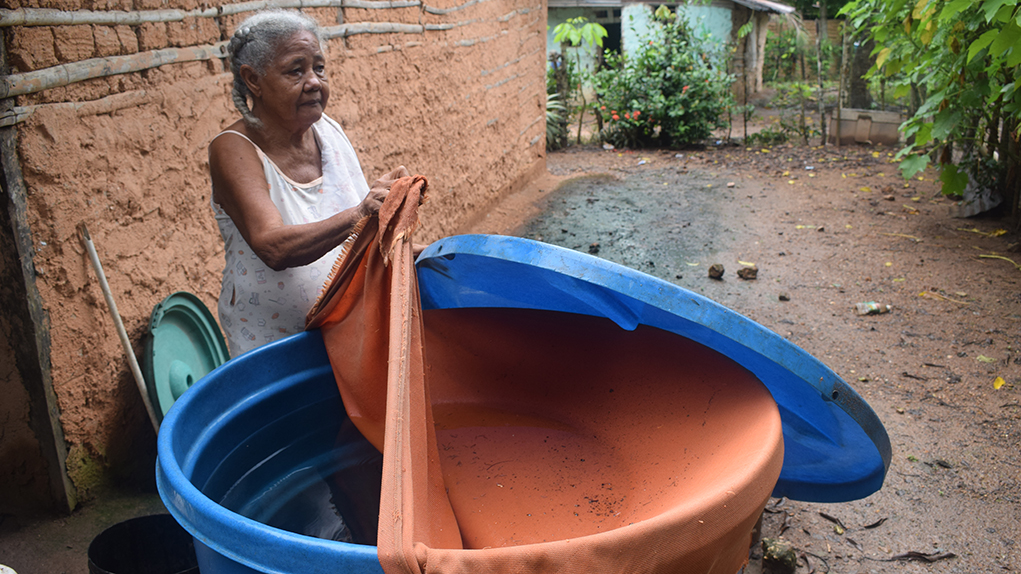
Ana Milena reconoce que la situación de salud pública ha mejorado, pero no cree que sea porque la calidad del agua ha mejorado, sino por los cuidados comunitarios que han adoptado: “Por lo menos aquí en mi casa a los niños los he llevado al hospital y les salió que no se pueden bañar con el agua del canal, no se pueden bañar con el agua de la represa porque es lo que les está produciendo esos brotes en la piel”.
En su hogar optaron por no tomar el agua del acueducto. Como otras familias de la comunidad, consumen agua lluvia y en verano van hasta la vereda Paso el Medio, ubicado a un kilómetro en el mismo corregimiento de Matuya, y extraen con bombas manuales el agua de pozos.
“Como acá en mi casa nosotros tenemos una moto, el hijo mío sale y me trae el agua. Cuando no teníamos moto, como yo tenía un amigo que tenía una camioneta que llegaba al acueducto, él me hacía el favor”, cuenta Nisley María Contrera, de 24 años, habitante de La Suprema.
Otras mujeres deben pagarle dos mil pesos a algún motorizado para que les traiga una garrafa, que puede durar, en el mejor de los escenarios, un día. “Pero aquí no todos lo hacen porque eso cuesta. Si yo le pido el servicio a una moto, tengo que pagarle esas pimpinas de agua”, señala Estrada. Por eso, explica que “aquí la mayoría de la comunidad la consume —el agua de la pluma—, pero pasan sufriendo diarrea, vómitos, dolor de estómago, rasquiña”.
En 2018, la Corporación Desarrollo Solidario (CDS), instauró un derecho de petición ante la Defensoría del Pueblo solicitando la revisión del incumplimiento de la sentencia de 2014. En respuesta, la Defensoría del Pueblo Regional de Bolívar presentó incidente de desacato en contra del entonces alcalde del municipio de María La Baja, Carlos Antonio Coronel Mena; el gerente de aguas de Bolívar, Miguel Torres Scaff; y el director de Promoción y Prevención del Ministerio de Salud, Elkin de Jesús Osorio Saldarriaga. El 17 de julio del 2018, el Tribunal Administrativo de Bolívar resolvió abrir el desacato contra los funcionarios públicos.
La posibilidad de que las comunidades rurales de María La Baja accedan a un territorio con agua potable siguen en las manos de varias instituciones, especialmente la administración municipal, pero el futuro es incierto, debido a la ineficiencia e indolencia de quienes conforman el aparato estatal.
***
Este reportaje fue realizado en el marco de la Coalición de Mujeres del Caribe por la Tierra y el Territorio y de la campaña Stand For Her Land-Colombia.

